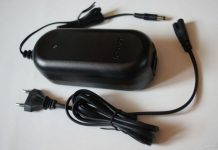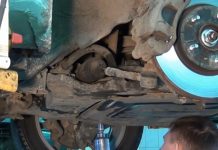In detail: do-it-yourself repair of the ipsum steering rack from a real master for the site my.housecope.com.
Symptoms: knocks in the steering rack, manifested when driving through small irregularities (disease of all korollopodobnye with electric power steering).
Diagnosis of servicemen - replacing the rail (in practice, it does not help out for long and costs a lot).
Solution: replacing anything in the rail that can knock. And there are only two places knocking in such rails - the adjusting unit and in the area of the bushing located at the opposite end of the rail (in the case of right-hand drive cars - the left side of the rail). And since nothing needs to be changed in the adjusting unit, all repairs are reduced to replacing the factory bushing with a custom-made one.
Patients: Will VS 2002 1.5 L (electric power steering!)
We climb into the pedal assembly and remove the protection from the steering shaft, unscrew it by hand, and remove it easily:
We completely unscrew the bolt securing the intermediate shaft to the crosspiece:
IMPORTANT! Put the wheels straight, remove the key from the ignition, lock the steering wheel. This is done in order to prevent, after removing the rack, turning the steering wheel by a number of revolutions more than it should be. Otherwise, a break in the wires of the "snail" of the airbag and the resulting malfunction of the latter are inevitable.
We hang out in front of the car and throw off the wheels (front enough).
Next is the removal of the steering rack. It has been proven from our own experience that it is possible to unscrew the rail fasteners without additional disassembly, but pulling out the rail is very time consuming. Do not waste time, twist the stretcher - you will save a lot of time and effort.
But first - the steering tips: take out the cotter pin, unscrew the nut, hit the place indicated below with a sharp, biting hammer blow, and the finger falls out by itself (we do it with both sides
We unscrew the subframe, 4 bolts to the body, 3 bolts in the area of the rear engine mount and 3 nuts in the same place.
After that, the subframe, together with the rack, gently (if you planned to unscrew the last bolt correctly) lowers and hangs on the levers and the anti-roll bar. Everything - the rail at a glance: unscrew:
We remove and carry to the workbench
Let's start disassembling it:
1) Remove the rubber boot.
2) Take the 12 key and unscrew the bolt shown in the photo.
3) Remove the intermediate shaft.
4) Unscrew the lock nut (used a gas wrench)
5) Unscrew the clamping cup of the rack shaft.

6) Then we put on and fix the intermediate shaft again, then take out the entire shaft with the bearing with a light blow with a copper hammer on it.
7) Turning the rail over, disassemble the adjusting unit: unscrew the lock nut with a 41 key
8) Then we unscrew the adjusting cup using any flat object, take out the spring and the pressure piston.


9) Remove the left anther, very carefully so as not to break (we draw inside around the circumference of the anther with a non-sharp object)

10) Unscrew the left rod from the rail using keys 29 and 22.
11) On the back side, we loosen the large clamp and detach the boot.
12) Take the rolling pin out of the rail, put it aside.
| Video (click to play). |
13) We look at the rail from the left end - we see an aluminum hold-down washer, behind it is the notorious bushing.


14) We hook the washer with a hook and knock it out, then take out the sleeve.
Here it is - the sleeve, because of which all the ailments. )
 For left hand drive
For left hand drive
Modifying a pre-made PTFE bushing according to the attached drawing.

15) On the new sleeve, we make a longitudinal cut necessary for its compression and setting in place. We orient the cut in the direction of the car's movement - in this direction the rail experiences the least stress.
16) Lubricate the sleeve and gently straighten the sleeve, check the fit of the sleeve with the free end of the rolling pin.
17) Press in the aluminum washer with a suitable head. Insert the rolling pin into place. We insert the shaft into place, for this, with a 22 key, we swing the rolling pin around its axis and at the same time push the shaft - at a certain moment the gears are aligned and the shaft falls through. We tighten the clamping sleeve of the shaft until it stops, we counter it with a lock nut. We assemble the adjusting unit, tighten the adjusting cup until it stops and release it by 90 degrees, counter nut with a counter nut. Subsequently, the tightening torque can be adjusted on the machine after a test drive with a certain skill, the mechanism must be tightened until the steering wheel returns to the straight position when exiting the turn. Pull into place, anthers into place, tighten. Rail for stretcher, stretcher for cars. Near the rear (in relation to the rear of the car) fastenings of the subframe to the body there are holes on the body and on the subframe, the combination of which excludes the removal of the caster. (holes in the photo)
 Tips to the levers, set the wheels straight, the steering wheel is straight from the very beginning. We pull everything in and climb into the salon. There we loosen the upper crosspiece, move the shaft between the crosspieces up and put the lower crosspiece on the intermediate shaft. We are tightening everything. Subsequently, you can similarly align the steering wheel if, when driving straight, the steering wheel looks slightly to the side.
Tips to the levers, set the wheels straight, the steering wheel is straight from the very beginning. We pull everything in and climb into the salon. There we loosen the upper crosspiece, move the shaft between the crosspieces up and put the lower crosspiece on the intermediate shaft. We are tightening everything. Subsequently, you can similarly align the steering wheel if, when driving straight, the steering wheel looks slightly to the side.
It's just that when I was sorting out the rail, the verdict was announced that the current is coming to a kicker with one thrust, and when I went to make a descent, I was told that the full kicker had already arrived, and the knock strains me and the topic of the starter reassured me with a decision))). Yes, and I try not to screw up the typewriter))))
Comrades, advice is needed - a strange, quiet knock “knock-knock” “knock-knock” knock appeared in front. the car is coasting at low speed, the steering wheel is left and right, the car sways a little and “he” appears that this knock is both left and right. Quite recently, I replaced everything that was possible on the chassis, I began to sin on the steering rods.
can they tap so quietly and unpleasantly?
and there was also a completely unpleasant "clatter" in the steering wheel itself, the feeling that this clatter was straight on the airbag, took off the pillow, removed all the levers of the wipers and turn signals, got to the bearing, which is rolled on the shaft, but everything seems to be holding on dead there. a plastic sleeve, which I changed below on the shaft. Kardanchik, which in the cabin can not so "blur". but the sound is right at the very top. already broke my head, what could it be
An innovative idea allows you to cheaply repair the steering rack with your own hands. Those who wish are given the opportunity to learn from experience and, using available materials, improve this part of the mechanism of their car.
This video provides information on the innovative idea and the use of materials at home when troubleshooting steering rack problems at home. A non-standard approach to eliminating extraneous sounds while driving, delights in its simplicity and results. This solution will allow you to forget about the knocking steering rack for a long time.
For everyone who wants to watch the original repair of the steering rack with their own hands, the video clip provides such an opportunity. Troubleshooting steps for the device that controls the movement of the wheels and the direction of the vehicle include:
- unscrewing the bolts and squeezing out the clamps with the steering wheel unscrewed with a 22 mm spanner wrench;
- removing the bushings and unscrewing the bolt on the steering column in the passenger compartment in the area of the pedals with a 14 mm wrench;
- removing clamps from the steering rack and removing the device through the wheel;
- releasing the steering rack from thin clamps using an awl and a thin screwdriver and an anther;
- preparation of several pieces of plastic from watering cans, cans and other products to fill the free space between the metal rail body and the support sleeve.The size of the blanks must correspond to the length and width of the recess for the sleeve to move;
- inserting blanks inside the steering rack until it stops against the bushing, among which the last element should be the most rigid;
- checking the free movement of the sleeve over the plastic, tightly installed in the rack cavity;
- installation of the steering rack in place.
This solution eliminates the knock of the support sleeve for a long period of time.



















